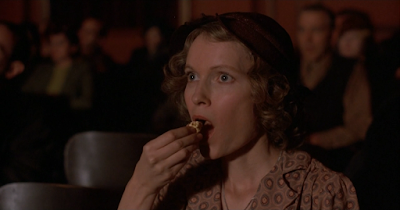I've been blogging a long time (13 + years) – lately not so much. I mean, after a while, you kind of run out of novel things to say. Plus – man, are there some great classic film bloggers out there. I am amazed, not only at their writing ability, but at their intricate knowledge of all the things that go into making movies. You know, all that behind-the-scenes stuff, like writing, directing, cinematography, etc.
 |
| It might be hard to keep your mind on the screen here.... |
Alas, I am nowhere in the same league. Sometimes I just feel like throwing in the towel because I am not an expert in anything (and don’t have the nerve to pass myself off as one).
But.
But I do admit you would have to go a long way to find my equal when it comes to being starstruck. Those pictures you see of the enraptured movie goer, sitting on the edge of their seat, hand poised between popcorn and mouth, eyes wide and glued to the screen? Yup, that’s me.
 |
| Yes, Mia, I totally get it. |
Billy Wilder has William Holden as Joe Gillis in “Sunset Boulevard” say “Audiences don’t know somebody sits down and writes a picture; they think the actors make it up as they go along.” Of course I know that. But, when I’m lost in a film, I don’t care. I want to believe. Maybe that’s the filmmakers curse – they work so hard at make believe that their own contribution is ultimately ignored. Do you sit though all of the interminable credits at the end of the film these days? I don’t. I just want to see who was in it.
You know how you can pretty much find a Seinfeld episode that relates to every incident in life? Well, I can pretty much do that with movies. I have to keep those references in my head most times, because I’ve had the “poor thing: can’t relate to real life” look too many times. Or worse, the “WTF is she talking about?” look. Actually, I kind of like that one.
There is nothing like a great star of the classic era. I’m aware that it took an entire industry to produce such glorious beings for our consumption, but I don’t want to know. I don’t care that Rita Hayworth had her hairline painfully altered, I only care to see her shimmering image on film. I want to believe that they emerged – full-fledged and fascinating – on the screen.
Charles Foster Kane had his Declaration of Principles. No matter that he betrayed each and every one of them, but he had them. And here are this lowly starstruck willfully ignorant fan’s Seven Rules of Classic Film Fascination:
1. There must be music in the background: Does mood music follow you around all day? Well, in the movies it does and it is perfectly normal. No questions asked.
2. Do you wake up in full make-up and perfectly coiffed hair? Only movie stars do. They really do.
3. Can life’s stories be brought to conclusion in approximately 2 hours or less. In the movies they can. Or at least, in most classic films they can. Anyone see “Oppenheimer” or “Killers of the Flower Moon”? Either learn to tighten it up, give us a potty/snack bar break or make a streaming series.
4. Only a great star can invite the illusion of intimacy. All the behind the scenes stuff can't make that.
5. There is always, always, an elegance about a star. And something unique – they neither look, nor sound, nor move quite like anyone else.
6. A film is not totally absorbing unless there is a star. A cast of unknowns don’t cut it.
7. How will you know 1-6 combine to create the brew that is a star or an unforgettable film? You will know it’s magic when it lingers in you thoughts and dreams, when it interjects itself into your real life, and when you never tire of repeated viewings of images or a film.
I am not now and never will be a film scholar, although I have lots of odd facts rumbling around in my brain. Please don’t ask me about geography, but I can tell you a lot about Clara Bow. I was what the movies was made for: open to magic, open to dreaming, open to the secret life that lives within.
 |
| Go on...ask me |
Maybe I’ll go on blogging, maybe not. I started blogging because I felt the need to share my love of the movie-going/watching experience, but maybe this one entry is all I have left to say. I do like participating in some blogathons because it forces me to write, but right now my only topic is that of surrender – surrender to the magic of the finished product. It's bliss in a world filled with anything but at times.














































